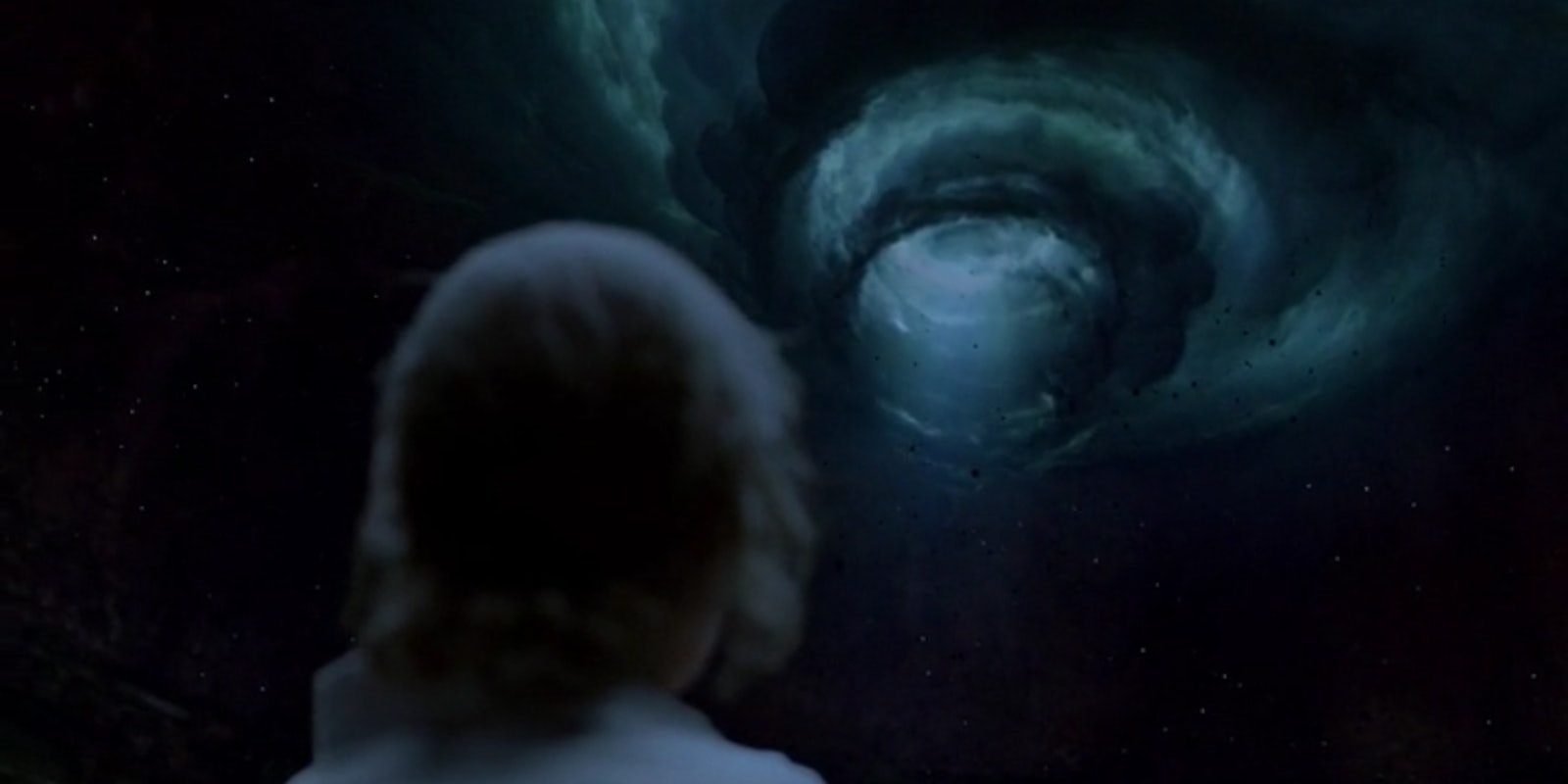We know you gasped and screamed your way through last night’s True Detective season finale. A hodgepodge of homages to everything from Texas Chainsaw Massacre to vintage pulp horror and Twin Peaks, last night’s eighth episode had everything—including some references you might have missed. Here are 5 handy allusions you might have missed among the series’ many literary and cultural nods. Spoilers ahead!
1) Errol may not be the Yellow King, but he is the ErlKing
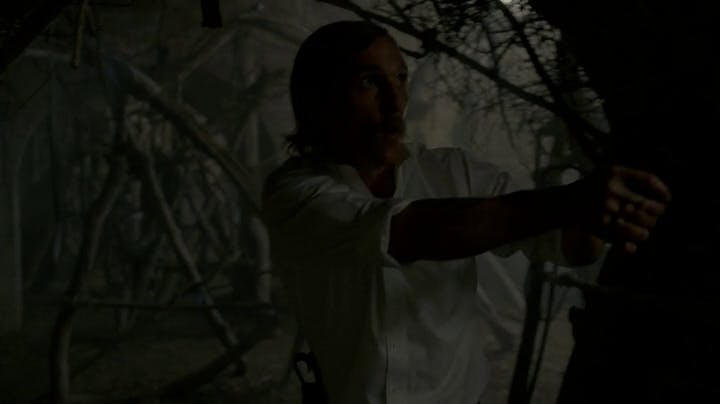
Though he may not be listed in any birth register, Errol, the son of the terrifying Sheriff Childress, has his name in a much older book: Grimm’s Fairytales. The name “Earl” is synonymous with the title of “Earl” in English, which is linked to the Germanic title of “Earl-king.” In Germanic folklore, the “Erlking” is the King of the Elves. But he’s also, according to Goethe’s famous ballad Der Erlkoenig, evil, deadly, and a child predator. In Der Erlkoenig, the Erlking attempts to lure, then use violence against a little boy who’s captured his attentions:
Do you want to come with me, pretty boy?
My daughters shall wait on you finely;
My daughters will lead the nightly dance,
And rock and dance and sing you to sleep.
Not only is this a chilling description of the ritualistic ceremonies Errol and the others in the cult perform on their victims, but in the finale, he attempts to seduce Rust to his death in the same way. As he lures Rust deeper into the labyrinthine “forest” that is Carcosa, Errol calls Rust “Little prince,” and asks, “Do you know what I would do to all the sons and daughters of man?” as if he himself is more than human.
2) We are all Inhabitants of Carcosa
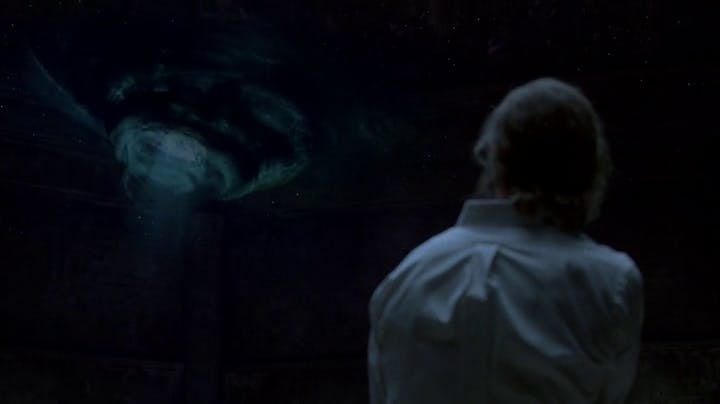
Much has been made of True Detective‘s references to Robert W. Chambers’ 1895 weird fiction classic The King in Yellow. True Detective’s finale shows Rust enacting a moment similar to one described in a story from The King in Yellow called “In the Court of the Dragon:”
I raised my seared eyes to the fathomless glare, and I saw the black stars hanging in the heavens: and the wet winds from the lake of Hali chilled my face.
But there’s an even more vivid depiction of what happenns to Rust in an earlier inspiration for Chambers, Ambrose Bierce’s 1891 short story “An Inhabitant of Carcosa.” In it the narrator finds himself removed from civilzation and seeking the city of Carcosa. In the story’s climactic moment, the speaker looks up at the sky and knows an overpowering moment of existential dread:
Looking upward, I saw through a sudden rift in the clouds Aldebaran and the Hyades! In all this there was a hint of night — the lynx, the man with the torch, the owl. Yet I saw—I saw even the stars in absence of darkness. I saw, but was apparently not seen nor heard. Under what awful spell did I exist?
Yep, this is pretty much exactly what happens to Rust in Carcosa’s innermost chamber.
3) Who Watches the Dark?
Throughout its first season, True Detective obliquely references many of the themes in Alan Moore’s acclaimed dark comic classic The Watchmen, itself a gritty, violent tale of expansive government corruption that’s littered with references to pulp fiction and weird horror. But there’s also a far more direct Moore reference in the last scene of last night’s episode.
Rust’s moving speech about the battle between the light versus the darkness is almost an exact quote of Moore’s Top Ten, an acclaimed 1999 sci-fi comic that uses interaction between humans and a wide range of alien species to explore ideas about societal prejudice and political injustice. Rust Cohle’s inspiration is an alien named Kapela, who tells his partner, Nebula, that space is “an immense board of lights”…
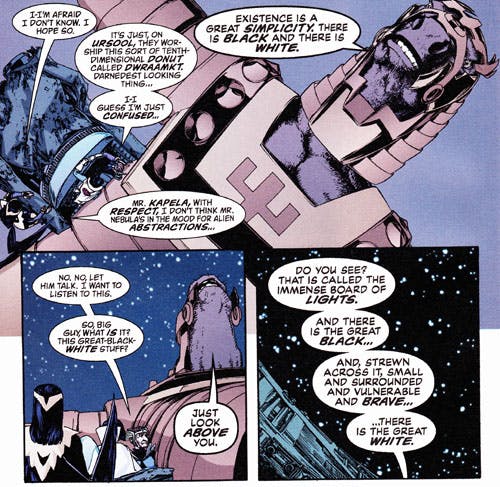
…and that now the light is winning. Read the whole moment at Crisis on Earth.
4) Rust is Jesus…
No, really. Earlier in the series, he tells Marty he’s been thinking about Jesus in the Garden of Gethsemane, and Christ’s decision to allow his own crucifixion. If the look on his face as he enters Carcossa doesn’t tell you everything you need to know about Rust’s mental state, his conviction that he wasn’t supposed to come back from the experience fills in the rest. But if you need visuals, here are all the ways in which the finale stages him in numerous visual references to Christ.
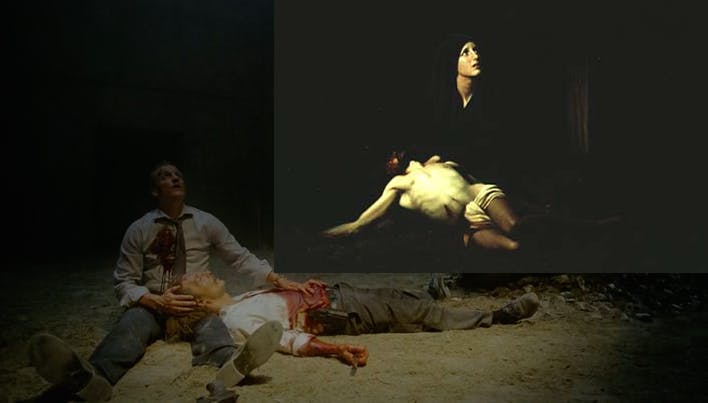
The Pieta, depicted here with art by Frank Covino…
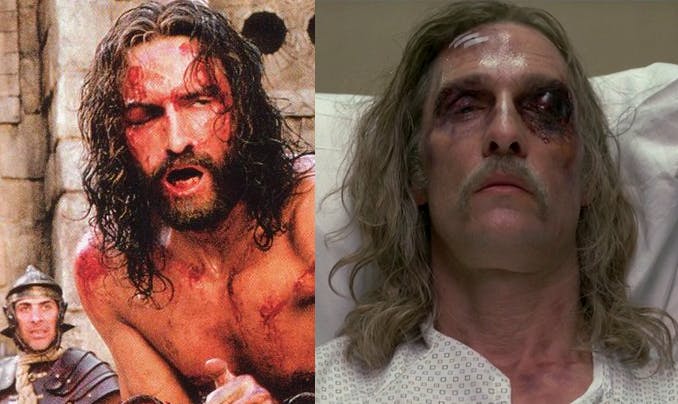
Bruised and bleeding (and yes, we think that’s a cross emblazoned on his forehead)…
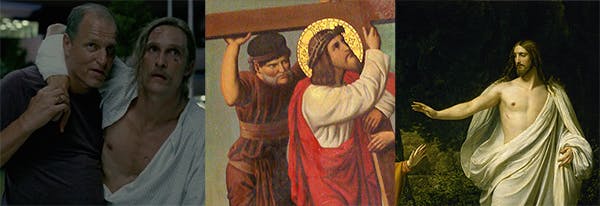
…and of course, staged with Marty as Simon of Cyrene carrying his cross.
Not to mention the parts where he was stabbed in the gut (like Jesus) and miraculously came back from the dead (like Jesus).
5) ….Which might make him the new Yellow King.
If you want to go even deeper into the ideas of the Yellow King mythology, in the opening story to Chambers’ collection, “The Repairer of Reputations,” the narrator goes mad after having read the entirety of a play entitled The King in Yellow. After failing in a diabolical and gruesome plot to crown himself The Yellow King, he makes a last stand, surrounded by former friends who are now fully horrified at his transformation:
But I still raged, bleeding and infuriated among them, and more than one policeman felt my sharp teeth. Then when I could no longer move they came nearer; I saw old Hawberk, and behind him my cousin Louis’ ghastly face, and farther away, in the corner, a woman, Constance, weeping softly.
“Ah! I see it now!” I shrieked. “You have seized the throne and the empire. Woe! woe to you who are crowned with the crown of the King in Yellow!”
The final lines don’t make it clear who he thinks is the new king, but it looks as though his suspicions have fallen on Constance, an innocent bystander who has been weeping in horror. While he’s been trying to keep his cousin from stealing the title of King in his head, Constance may be the usurper who now has to bear the horror of the crown. Is Constance a parallel with Rust, who has an overwhelming encounter with death and the cosmos that leaves him weeping in the season’s final moments?
In the inner chamber of Carcossa, there’s a yellow skeleton king which appears to be sitting on a throne. A closer look reveals the skeleton has the cult’s symbol, the omnipresent spiral, carved on its forehead. Here’s a side-by-side of the skeleton with the cross that seems to be emblazoned on Rust’s forehead:
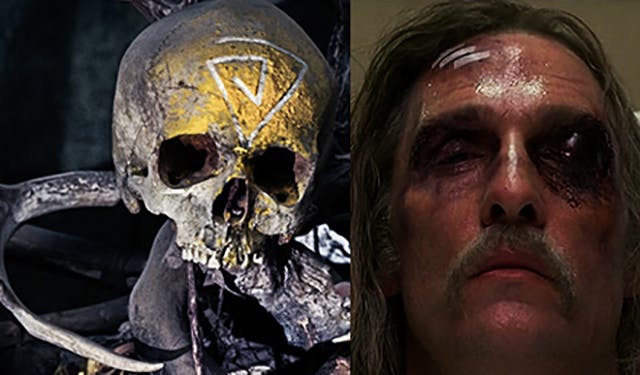
What do you think? Is Rust the new Yellow King?
Screengrabs via HBO Go; Pieta by Frank Corvino

